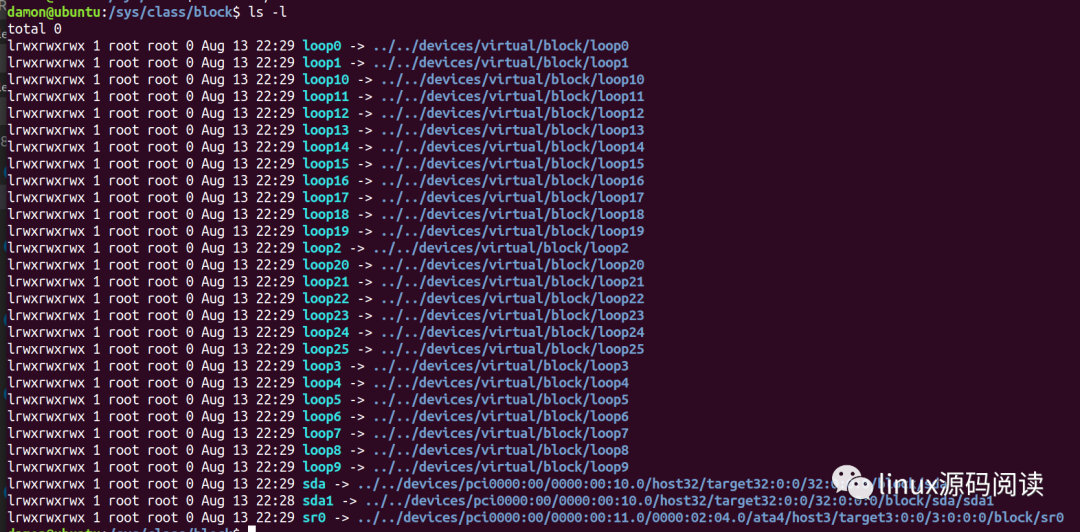жң¬ж–Үдё»иҰҒд»Ӣз»Қи®ҫеӨҮжЁЎеһӢд№Ӣclassз»“жһ„дҪ“гҖҒеҲқе§ӢеҢ–еҸҠе…¶е·ҘдҪңжөҒзЁӢгҖӮ
ж„ҹи°ўжӮЁе…іжіЁLinuxжәҗз Ғйҳ…иҜ»е…¬дј—еҸ·пјҢжң¬е…¬дј—еҸ·жҢҒз»ӯеҸ‘еёғLinux 5.4зүҲжң¬зӣёе…ізҡ„ж–Үз« пјҢжӮЁд№ҹеҸҜд»ҘеңЁhttps://gitee.com/zgrxmm/linux_5.4_codeviewдёӢиҪҪжәҗз Ғе’ҢжіЁйҮҠпјҢд»ҘеҸҠжүҖжңүж–Үз« й“ҫжҺҘгҖӮ
йҳ…иҜ»д»Јз ҒпјҢзҹҘиҜҶжҖ»з»“дёҚжҳ“пјҢж„ҹи°ўеӨ§е®¶зӮ№иөһгҖҒе…іжіЁе’Ңж”ҜжҢҒпјҒ
ж¬ўиҝҺдёҖиө·еӯҰд№ гҖҒжҖ»з»“гҖҒе·©еӣәгҖҒиҝӣйҳ¶пјҒ
еҰӮжңүз–‘й—®пјҢж¬ўиҝҺз•ҷиЁҖжҲ–з§ҒдҝЎпјҒ
еүҚйқўеҮ зҜҮд»Ӣз»ҚдәҶLinuxеҶ…ж ёи®ҫеӨҮз®ЎзҗҶжЁЎеһӢdeviceгҖҒdevice_driverгҖҒbusжҖ»зәҝгҖҒueventжңәеҲ¶пјҢд»ҘеҸҠsysfsе’ҢkernfsпјҢжңүдәҶиҝҷдәӣеҹәзЎҖзҹҘиҜҶд№ӢеҗҺпјҢеҶҚжқҘи®ӨиҜҶclassе°ұжҜ”иҫғйЎәе…¶иҮӘ然пјҢеӣ дёәе®ғжҳҜиҝҷдәӣи®ҫеӨҮе’Ңй©ұеҠЁзҡ„дёҖеұӮжҠҪиұЎз»“жһ„дҪ“гҖӮ
classжҳҜdeiveзҡ„й«ҳзә§и§ҶеӣҫпјҢе®ғжҠҪиұЎеҮәеә•еұӮзҡ„е®һзҺ°з»ҶиҠӮгҖӮй©ұеҠЁзЁӢеәҸеҸҜиғҪдјҡзңӢеҲ°SCSIзЈҒзӣҳжҲ–иҖ…ATAзЈҒзӣҳпјҢдҪҶжҳҜд»Һзұ»и§Ҷи§’жқҘзңӢпјҢе®ғ们йғҪжҳҜзЈҒзӣҳгҖӮclassе…Ғи®ёз”ЁжҲ·з©әй—ҙж №жҚ®и®ҫеӨҮзҡ„еҠҹиғҪпјҲиҖҢдёҚжҳҜи®ҫеӨҮзҡ„иҝһжҺҘж–№ејҸжҲ–е·ҘдҪңж–№ејҸпјүжқҘдҪҝз”Ёи®ҫеӨҮгҖӮ

жҢүз…§жғҜдҫӢпјҢзҗҶи§ЈдёҖдёӘжЁЎеқ—пјҢе…ҲдәҶи§Је®ғе®һзҺ°жүҖз”Ёзҡ„ж•°жҚ®з»“жһ„дҪ“гҖӮ
struct classе®ҡд№үеңЁinclude/linux/device.hеӨҙж–Ү件дёӯгҖӮ
struct class {const char *name; // зұ»зҡ„еҗҚз§°пјҢдјҡеңЁ/sys/classзӣ®еҪ•дёӢдҪ“зҺ°struct module *owner;const struct attribute_group **class_groups; // иҜҘclassй»ҳи®Өзҡ„attributesconst struct attribute_group **dev_groups; // иҜҘclassдёӢжҜҸдёӘи®ҫеӨҮзҡ„attributesstruct kobject *dev_kobj; // иҜҘclassдёӢзҡ„и®ҫеӨҮеңЁ/sys/dev/дёӢзҡ„зӣ®еҪ•пјҢзҺ°еңЁз”ұcharе’ҢblockдёӨдёӘзӣ®еҪ•// classд№ҹжңүueventжңәеҲ¶пјҢеҪ“иҜҘclassдёӢжңүи®ҫеӨҮеҸ‘з”ҹеҸҳеҢ–ж—¶пјҢеӣһи°ғиҜҘеҮҪж•°int (*dev_uevent)(struct device *dev, struct kobj_uevent_env *env);char *(*devnode)(struct device *dev, umode_t *mode);void (*class_release)(struct class *class); // иҜҘclassзҡ„йҮҠж”ҫеҮҪж•°void (*dev_release)(struct device *dev); // иҜҘclassеҶ…и®ҫеӨҮзҡ„еӣһи°ғеҮҪж•°пјҢеңЁdevive_releaseиҝҮзЁӢдёӯпјҢдјҡдҫқж¬ЎжЈҖжҹҘdeviceгҖҒdevice_typeд»ҘеҸҠdeviceжүҖеңЁclassзҡ„йҮҠж”ҫеӣһи°ғint (*shutdown_pre)(struct device *dev);const struct kobj_ns_type_operations *ns_type;const void *(*namespace)(struct device *dev);void (*get_ownership)(struct device *dev, kuid_t *uid, kgid_t *gid);const struct dev_pm_ops *pm;struct subsys_private *p; // з§ҒжңүжҢҮй’Ҳ};
struct subsys_privateжҳҜstruct classдёӯзҡ„дёҖдёӘжҲҗе‘ҳеҸҳйҮҸпјҢе®ҡд№үеңЁdrivers/base/base.hгҖӮ
иҜҘз»“жһ„дҪ“йӣҶеҗҲдәҶclassжЁЎеқ—жүҖйңҖзҡ„з§Ғжңүж•°жҚ®пјҢжҳҜдёҖдёӘе®һйҷ…зҡ„kobjectпјҢе…Ғи®ёе®үе…Ёең°йқҷжҖҒеҲҶй…Қ struct classгҖӮ
й©ұеҠЁзЁӢеәҸж ёеҝғд№ӢеӨ–зҡ„д»»дҪ•еҶ…е®№йғҪдёҚеә”и§ҰеҸҠиҝҷдәӣеӯ—ж®өгҖӮ
struct subsys_private {struct kset subsys; // е®ҡд№үиҜҘеӯҗзі»з»ҹзҡ„struct ksetstruct kset *devices_kset; // еӯҗзі»з»ҹзҡ„и®ҫеӨҮзӣ®еҪ•struct list_head interfaces; // е…іиҒ”зҡ„еӯҗзі»з»ҹжҺҘеҸЈеҲ—иЎЁstruct mutex mutex; // дҝқжҠӨи®ҫеӨҮе’ҢжҺҘеҸЈеҲ—иЎЁзҡ„й”Ғstruct kset *drivers_kset; // е…іиҒ”зҡ„й©ұеҠЁзЁӢеәҸеҲ—иЎЁstruct klist klist_devices; // з”ЁдәҺиҝӯд»Јdriver_ksetзҡ„kliststruct klist klist_drivers; // з”ЁдәҺиҝӯд»Јdrivers_ksetзҡ„kliststruct blocking_notifier_head bus_notifier; // жҖ»зәҝйҖҡзҹҘеҲ—иЎЁпјҢеҲ—еҮәжүҖжңүе…іеҝғиҜҘжҖ»зәҝдәӢ件зҡ„йҖҡзҹҘеҜ№иұЎunsigned int drivers_autoprobe:1;struct bus_type *bus; // жҢҮеҗ‘иҜҘз»“жһ„дҪ“е…іиҒ”зҡ„struct bus_typeзҡ„жҢҮй’Ҳstruct kset glue_dirs; // вҖңglueвҖқзӣ®еҪ•ж”ҫзҪ®еңЁзҲ¶и®ҫеӨҮд№Ӣй—ҙд»ҘйҒҝе…Қе‘ҪеҗҚз©әй—ҙеҶІзӘҒstruct class *class; // жҢҮеҗ‘иҜҘз»“жһ„дҪ“е…іиҒ”зҡ„struct classзҡ„жҢҮй’Ҳ};
struct class_attributeдёҺstruct device_attributeе’Ңstruct driver_attributeеҠҹиғҪзұ»дјјпјҢеҶ…йғЁйғҪжҳҜstruct attribute attrпјҢз»ҷclassзұ»attributeж–Ү件жҸҗдҫӣдәҶиҜ»еҶҷжҺҘеҸЈгҖӮ
struct class_attribute {struct attribute attr;ssize_t (*show)(struct class *class, struct class_attribute *attr,char *buf);ssize_t (*store)(struct class *class, struct class_attribute *attr,const char *buf, size_t count);};
еҜ№еә”зҡ„еҮҪж•°жҺҘеҸЈпјҡ
static ssize_t class_attr_show(struct kobject *kobj, struct attribute *attr,char *buf){struct class_attribute *class_attr = to_class_attr(attr);struct subsys_private *cp = to_subsys_private(kobj);ssize_t ret = -EIO;if (class_attr->show)ret = class_attr->show(cp->class, class_attr, buf);return ret;}static ssize_t class_attr_store(struct kobject *kobj, struct attribute *attr,const char *buf, size_t count){struct class_attribute *class_attr = to_class_attr(attr);struct subsys_private *cp = to_subsys_private(kobj);ssize_t ret = -EIO;if (class_attr->store)ret = class_attr->store(cp->class, class_attr, buf, count);return ret;}
struct class_interfaceз»“жһ„дҪ“иў«дёІеңЁstruct class->p->interfacesдёҠпјҢжҸҗдҫӣдәҶж·»еҠ и®ҫеӨҮе’Ң移йҷӨи®ҫеӨҮзҡ„жҺҘеҸЈгҖӮ
еҪ“жңүи®ҫеӨҮж·»еҠ еҲ°жүҖеұһclassзұ»ж—¶пјҢи°ғз”Ёadd_devеҮҪж•°гҖӮеҰӮжһңжҳҜе…ҲжіЁеҶҢдәҶи®ҫеӨҮпјҢеҗҺеҲӣе»әдәҶclassпјҢйӮЈд№ҲеҮҪж•°д№ҹдјҡжү§иЎҢдёҖж¬ЎгҖӮ
еҗҢзҗҶпјҢеҪ“жңүи®ҫеӨҮд»Һclassзұ»з§»йҷӨж—¶пјҢи°ғз”Ёremove_devеҮҪж•°гҖӮ
struct class_interface {struct list_head node;struct class *class;int (*add_dev) (struct device *, struct class_interface *);void (*remove_dev) (struct device *, struct class_interface *);};
иҝӣе…ҘеҲ°/sys/classзӣ®еҪ•пјҢеҸҜд»ҘзңӢеҲ°жңүеҗ„з§Қеҗ„ж ·зҡ„classгҖӮ

жҜҸдёӘclassзӣ®еҪ•дёӢеҸҲжңүеҫҲеӨҡи®ҫеӨҮгҖӮжҲ‘们д»Ҙblockзӣ®еҪ•дёәдҫӢгҖӮ

еҸҜд»ҘзңӢеҲ°blockзӣ®еҪ•дёӢзҡ„жүҖжңүж–Ү件йғҪжҳҜй“ҫжҺҘж–Ү件пјҢдё”йғҪжҳҜ/sys/devices/зӣ®еҪ•дёӯзҡ„и®ҫеӨҮзҡ„и¶…й“ҫжҺҘгҖӮ
struct classеҲқе§ӢеҢ–жҳҜи°ғз”ЁдәҶkset_create_and_addеҮҪж•°жҺҘеҸЈпјҢеҲӣе»әдәҶдёҖдёӘе…ЁеұҖзҡ„static struct kset *class_ksetзҡ„ksetеҸҳйҮҸпјҢ并е°ҶвҖңclassвҖқеҠ е…ҘеҲ°sysfsж–Ү件系з»ҹдёӯпјҢеҚіе®ҢжҲҗдәҶ/sys/classзӣ®еҪ•зҡ„еҲӣе»әгҖӮ
int __init classes_init(void){class_kset = kset_create_and_add("class", NULL, NULL);if (!class_kset)return -ENOMEM;return 0;}
class_createжҳҜдёӘе®ҸеҮҪж•°пјҢе®ҡд№үеңЁinclude/linux/device.hгҖӮ
({ \static struct lock_class_key __key; \__class_create(owner, name, &__key); \})
е®ғеҶ…йғЁжҳҜи°ғз”Ё__class_createеҮҪж•°еҲӣе»әclassпјҡи°ғз”Ёkzallocз”іиҜ·struct classз»“жһ„дҪ“пјҢ并е°Ҷnameе’Ңclass_releaseеҮҪж•°жҺҘеҸЈиөӢеҖјпјҢжңҖеҗҺи°ғз”Ё__class_registerе®ҢжҲҗжіЁеҶҢгҖӮ
struct class *__class_create(struct module *owner, const char *name,struct lock_class_key *key){struct class *cls;int retval;cls = kzalloc(sizeof(*cls), GFP_KERNEL);if (!cls) {retval = -ENOMEM;goto error;}cls->name = name;cls->owner = owner;cls->class_release = class_create_release;retval = __class_register(cls, key);if (retval)goto error;return cls;error:kfree(cls);return ERR_PTR(retval);}EXPORT_SYMBOL_GPL(__class_create);
пјҲ1пјүи°ғз”Ёkzallocз”іиҜ·struct subsys_privateз»“жһ„дҪ“еҸҳйҮҸпјҢ并еҲқе§ӢеҢ–е…¶еҶ…йғЁеҸҳйҮҸпјҢжҜ”еҰӮklist_devicesгҖҒinterfacesгҖҒglue_dirsгҖҒmutexгҖҒsubsys.kobjпјҢ然еҗҺдҪңдёәstruct classзҡ„з§ҒжңүеҸҳйҮҸгҖӮ
пјҲ2пјүи°ғз”Ёkset_registerжіЁеҶҢиҜҘclassпјҢжӯӨж—¶/sys/class/зӣ®еҪ•дёӢдҫҝжңүдәҶиҰҒжіЁеҶҢclassзҡ„зӣ®еҪ•гҖӮ
пјҲ3пјүжңҖеҗҺи°ғз”Ёclass_add_groupsе°Ҷclassз»“жһ„дҪ“дёӯзҡ„class_groupsжҢҮеҗ‘зҡ„attributeжіЁеҶҢеҲ°еҶ…ж ёдёӯгҖӮ
int __class_register(struct class *cls, struct lock_class_key *key){struct subsys_private *cp;int error;pr_debug("device class '%s': registering\n", cls->name);cp = kzalloc(sizeof(*cp), GFP_KERNEL);if (!cp)return -ENOMEM;klist_init(&cp->klist_devices, klist_class_dev_get, klist_class_dev_put);INIT_LIST_HEAD(&cp->interfaces);kset_init(&cp->glue_dirs);__mutex_init(&cp->mutex, "subsys mutex", key);error = kobject_set_name(&cp->subsys.kobj, "%s", cls->name);if (error) {kfree(cp);return error;}/* set the default /sys/dev directory for devices of this class */if (!cls->dev_kobj)cls->dev_kobj = sysfs_dev_char_kobj;#if defined(CONFIG_BLOCK)/* let the block class directory show up in the root of sysfs */if (!sysfs_deprecated || cls != &block_class)cp->subsys.kobj.kset = class_kset;#elsecp->subsys.kobj.kset = class_kset;#endifcp->subsys.kobj.ktype = &class_ktype;cp->class = cls;cls->p = cp;error = kset_register(&cp->subsys);if (error) {kfree(cp);return error;}error = class_add_groups(class_get(cls), cls->class_groups);class_put(cls);return error;}EXPORT_SYMBOL_GPL(__class_register);
struct classзҡ„й”ҖжҜҒжҳҜеҲӣе»әзҡ„йҖҶиҝҮзЁӢпјҢжҺҘеҸЈеҮҪж•°жҳҜclass_destroyпјҢеҶ…йғЁе®һзҺ°жҳҜи°ғз”ЁдәҶclass_unregisterжҺҘеҸЈгҖӮ
void class_destroy(struct class *cls){if ((cls == NULL) || (IS_ERR(cls)))return;class_unregister(cls);}void class_unregister(struct class *cls){pr_debug("device class '%s': unregistering\n", cls->name);class_remove_groups(cls, cls->class_groups);kset_unregister(&cls->p->subsys);}
еҗ‘classдёӯж·»еҠ и®ҫеӨҮпјҢе…¶е®һжҳҜи°ғз”ЁдәҶdevice_addеҮҪж•°жҺҘеҸЈпјҢе’Ңclassзӣёе…ізҡ„дё»иҰҒйҖ»иҫ‘жҳҜи°ғз”Ёdevice_add_class_symlinks()еңЁdevдёӢеҲӣе»әдёҖдёӘиҪҜй“ҫжҺҘsubsystemпјҢжҢҮеҗ‘зӣёеҜ№еә”зҡ„classгҖӮ

struct deviceз»“жһ„дҪ“и°ғз”Ёdevice_initialize()еҮҪж•°е®ҢжҲҗеҲқе§ӢеҢ–еҗҺпјҢи°ғз”Ёdevice_add()еҮҪж•°е°Ҷе…¶ж·»еҠ еҲ°и®ҫеӨҮй©ұеҠЁжЁЎеһӢдёӯпјҡ
(1) и°ғз”Ёget_device()жқҘеўһеҠ devзҡ„еј•з”Ёи®Ўж•°.
(2) 然еҗҺи°ғз”Ёdevice_private_init()иҝӣиЎҢdev->pзҡ„еҲҶй…Қе’ҢеҲқе§ӢеҢ–.
(3) и°ғз”Ёdev_set_name()еҜ№devзҡ„еҗҚеӯ—иҝӣиЎҢи®ҫзҪ®.
жҺҘдёӢжқҘпјҢйңҖиҰҒе°Ҷdevж·»еҠ еҲ°sysfsи®ҫеӨҮж–Ү件系з»ҹдёӯпјҡ
(4) йҰ–е…ҲжҳҜи°ғз”Ёget_device()еўһеҠ еҜ№parenзҡ„еј•з”Ёи®Ўж•°пјҲж— и®әжҳҜзӣҙжҺҘжҢӮеңЁparentдёӢиҝҳжҳҜйҖҡиҝҮдёҖдёӘзұ»еұӮжҢӮеңЁparentдёӢйғҪиҰҒеўһеҠ parentзҡ„еј•з”Ёи®Ўж•°пјү.
(5) 然еҗҺи°ғз”Ёget_device_parent()жүҫеҲ°е®һйҷ…иҰҒеҠ е…Ҙзҡ„зҲ¶kobjectпјҢ并и°ғз”Ёkobject_add()е°Ҷdev->kobjеҠ е…ҘеҲ°dev->kobj.parentзҡ„еұӮж¬Ўз»“жһ„дёӯ.
жҺҘдёӢжқҘжҳҜе®ҢжҲҗеұһжҖ§е’ҢеұһжҖ§йӣҶеҗҲзҡ„ж·»еҠ :
(6) и°ғз”Ёdevice_create_file()ж·»еҠ ueventеұһжҖ§ж–Ү件.
(7) 然еҗҺи°ғз”Ёdevice_add_class_symlinks()еңЁdevдёӢеҲӣе»әдёҖдёӘиҪҜй“ҫжҺҘsubsystemпјҢжҢҮеҗ‘зӣёеҜ№еә”зҡ„class.
(8) 然еҗҺ继з»ӯи°ғз”Ёdevice_add_attrs()ж·»еҠ еұһжҖ§е’ҢеұһжҖ§йӣҶеҗҲ.
(9) и°ғз”Ёbus_add_device()ж·»еҠ и®ҫеӨҮзҡ„жҖ»зәҝеұһжҖ§пјҢеңЁdevдёҺbusд№Ӣй—ҙеҲӣе»әиҪҜй“ҫжҺҘпјҢ并е°ҶdevжҢӮе…ҘеҲ°жҖ»зәҝзҡ„и®ҫеӨҮй“ҫиЎЁдёӯеҺ».
(10) dpm_sysfs_add()з”ЁдәҺеўһеҠ devдёӢзҡ„powerеұһжҖ§йӣҶеҗҲ.
(11) и°ғз”Ёdevice_pm_add()е°Ҷи®ҫеӨҮж·»еҠ еҲ°dpm_listй“ҫиЎЁдёӯеҺ»гҖӮ
(12) еҰӮжһңи®ҫеӨҮиў«еҲҶй…ҚдәҶдё»и®ҫеӨҮеҸ·пјҢи°ғз”Ёdevice_create_file()ж·»еҠ devеұһжҖ§ж–Ү件.
(13) 然еҗҺи°ғз”Ёdevice_create_sys_dev_entry()еңЁ/sys/devдёӢеҲӣе»әзӣёеә”зҡ„иҪҜй“ҫжҺҘ.
(14) и°ғз”Ёdevtmpfs_create_node()еңЁ/devдёӢж·»еҠ еҜ№еә”зҡ„и®ҫеӨҮиҠӮзӮ№ж–Ү件гҖӮ
(15) еҮҪж•°ејҖе§Ӣи°ғз”Ёkobject_uevent()еҗ‘з”ЁжҲ·з©әй—ҙеҸ‘еёғKOBJ_ADDж¶ҲжҒҜйҖҡзҹҘ.
(16) и°ғз”Ёbus_probe_device()дёәи®ҫеӨҮжҺўжөӢеҜ»жүҫеҗҲйҖӮзҡ„й©ұеҠЁзЁӢеәҸ.
(17) еҰӮжһңи®ҫеӨҮжңүзҲ¶иҠӮзӮ№зҡ„иҜқпјҢеҲҷжҠҠdev->p->knode_parentжҢӮе…ҘеҲ°parent->p->klist_childrenй“ҫиЎЁдёӯ.
(18) еҰӮжһңи®ҫеӨҮжңүжүҖеұһзҡ„classпјҢеҲҷе°Ҷdev->knode_classжҢӮе…Ҙclass->p>class_devicesдёҠпјҢ并и°ғз”ЁеҸҜиғҪзҡ„зұ»и®ҫеӨҮжҺҘеҸЈadd_dev()еҮҪж•°.
(19) еҜ№дәҺзӣҙжҺҘеңЁbusдёҠзҡ„и®ҫеӨҮжқҘи®ІпјҢеҸҜд»Ҙи°ғз”Ёbus_probe_device()жқҘжҹҘжүҫй©ұеҠЁзЁӢеәҸ.
(20) дҪҶжҳҜдёҚдёҺbusзӣҙжҺҘжҺҘи§Ұзҡ„и®ҫеӨҮпјҢеҲҷйқ classжқҘеҺ»еҜ»жүҫй©ұеҠЁпјҢдҫҝдҪҝз”ЁдәҶclass_interfaceеҶ…зҡ„add_dev()ж–№ејҸ.
(21) еҮҪж•°жңҖеҗҺи°ғз”Ёput_device()еҮҸе°‘еңЁејҖеӨҙеўһеҠ зҡ„引用计数并иҝ”еӣһгҖӮ
int device_add(struct device *dev){struct device *parent;struct kobject *kobj;struct class_interface *class_intf;int error = -EINVAL;struct kobject *glue_dir = NULL;dev = get_device(dev); // еўһеҠ еј•з”Ёи®Ўж•°if (!dev)goto done;if (!dev->p) {error = device_private_init(dev); // еҲҶй…Қе’ҢеҲқе§ӢеҢ–device->pif (error)goto done;}/** for statically allocated devices, which should all be converted* some day, we need to initialize the name. We prevent reading back* the name, and force the use of dev_name()*/if (dev->init_name) {dev_set_name(dev, "%s", dev->init_name); // и®ҫзҪ®и®ҫеӨҮеҗҚз§°dev->init_name = NULL;}/* subsystems can specify simple device enumeration */if (!dev_name(dev) && dev->bus && dev->bus->dev_name)dev_set_name(dev, "%s%u", dev->bus->dev_name, dev->id);if (!dev_name(dev)) {error = -EINVAL;goto name_error;}pr_debug("device: '%s': %s\n", dev_name(dev), __func__);parent = get_device(dev->parent); // еўһеҠ еҜ№зҲ¶иҠӮзӮ№и®ҫеӨҮзҡ„еј•з”Ёи®Ўж•°kobj = get_device_parent(dev, parent);if (IS_ERR(kobj)) {error = PTR_ERR(kobj);goto parent_error;}if (kobj)dev->kobj.parent = kobj; // и®ҫзҪ®dev->kobjзҲ¶иҠӮзӮ№зҡ„kobj/* use parent numa_node */if (parent && (dev_to_node(dev) == NUMA_NO_NODE))set_dev_node(dev, dev_to_node(parent));/* first, register with generic layer. *//* we require the name to be set before, and pass NULL */error = kobject_add(&dev->kobj, dev->kobj.parent, NULL); // е°ҶdeviceеҶ…еөҢзҡ„kobjеҠ е…ҘеҲ°kobjectжӢ“жү‘з»“жһ„дёӯif (error) {glue_dir = get_glue_dir(dev);goto Error;}/* notify platform of device entry */error = device_platform_notify(dev, KOBJ_ADD);if (error)goto platform_error;error = device_create_file(dev, &dev_attr_uevent); // ж·»еҠ ueventеұһжҖ§ж–Ү件if (error)goto attrError;error = device_add_class_symlinks(dev); // еҲӣе»әdevдёҺclassиҪҜй“ҫжҺҘif (error)goto SymlinkError;error = device_add_attrs(dev); // ж·»еҠ еұһжҖ§ж–Ү件if (error)goto AttrsError;error = bus_add_device(dev); // е°Ҷи®ҫеӨҮж·»еҠ еҲ°жҖ»зәҝдёҠпјҢеҲӣе»әdevдёҺbusд№Ӣй—ҙзҡ„иҪҜиҝһжҺҘif (error)goto BusError;error = dpm_sysfs_add(dev); // ж·»еҠ devдёӢpowerзҡ„еұһжҖ§йӣҶеҗҲif (error)goto DPMError;device_pm_add(dev);if (MAJOR(dev->devt)) { // дё»и®ҫеӨҮеҸ·еӯҳеңЁerror = device_create_file(dev, &dev_attr_dev); // ж·»еҠ devеұһжҖ§if (error)goto DevAttrError;error = device_create_sys_dev_entry(dev); // еңЁ/sys/devдёӢж·»еҠ еҜ№еә”зҡ„иҪҜй“ҫжҺҘif (error)goto SysEntryError;devtmpfs_create_node(dev); // еңЁ/devдёӢж·»еҠ зӣёеә”зҡ„и®ҫеӨҮиҠӮзӮ№}/* Notify clients of device addition. This call must come* after dpm_sysfs_add() and before kobject_uevent().*/if (dev->bus)blocking_notifier_call_chain(&dev->bus->p->bus_notifier,BUS_NOTIFY_ADD_DEVICE, dev);kobject_uevent(&dev->kobj, KOBJ_ADD); // е°ҶkobjectеҸ‘еёғеҲ°KOBJ_ADDж¶ҲжҒҜеҲ°з”ЁжҲ·з©әй—ҙbus_probe_device(dev); // дёәи®ҫеӨҮжүҫеҲ°еҗҲйҖӮзҡ„й©ұеҠЁif (parent)klist_add_tail(&dev->p->knode_parent,&parent->p->klist_children);if (dev->class) {mutex_lock(&dev->class->p->mutex);/* tie the class to the device */klist_add_tail(&dev->p->knode_class,&dev->class->p->klist_devices); // е°ҶиҠӮзӮ№жҸ’е…ҘеҲ°й“ҫиЎЁдёӯ/* notify any interfaces that the device is here */list_for_each_entry(class_intf,&dev->class->p->interfaces, node)if (class_intf->add_dev)class_intf->add_dev(dev, class_intf);mutex_unlock(&dev->class->p->mutex);}done:put_device(dev);return error;SysEntryError:if (MAJOR(dev->devt))device_remove_file(dev, &dev_attr_dev);DevAttrError:device_pm_remove(dev);dpm_sysfs_remove(dev);DPMError:bus_remove_device(dev);BusError:device_remove_attrs(dev);AttrsError:device_remove_class_symlinks(dev);SymlinkError:device_remove_file(dev, &dev_attr_uevent);attrError:device_platform_notify(dev, KOBJ_REMOVE);platform_error:kobject_uevent(&dev->kobj, KOBJ_REMOVE);glue_dir = get_glue_dir(dev);kobject_del(&dev->kobj);Error:cleanup_glue_dir(dev, glue_dir);parent_error:put_device(parent);name_error:kfree(dev->p);dev->p = NULL;goto done;}EXPORT_SYMBOL_GPL(device_add);
еҗ‘classдёӯж·»еҠ interfaceжҳҜи°ғз”ЁдәҶclass_interface_registerеҮҪж•°жҺҘеҸЈпјҢе®ғйҰ–е…ҲжҳҜе°Ҷclass_intfж·»еҠ еҲ°parent->p->interfacesй“ҫиЎЁдёӯпјҢеҰӮжһңclass_intf->add_devеҮҪж•°жҺҘеҸЈеӯҳеңЁпјҢеҲҷйҒҚеҺҶиҜҘclassдёӢзҡ„жүҖжңүи®ҫеӨҮпјҢеҜ№deviceжү§иЎҢclass_intf->add_devгҖӮ
int class_interface_register(struct class_interface *class_intf){struct class *parent;struct class_dev_iter iter;struct device *dev;if (!class_intf || !class_intf->class)return -ENODEV;parent = class_get(class_intf->class);if (!parent)return -EINVAL;mutex_lock(&parent->p->mutex);list_add_tail(&class_intf->node, &parent->p->interfaces);if (class_intf->add_dev) {class_dev_iter_init(&iter, parent, NULL, NULL);while ((dev = class_dev_iter_next(&iter)))class_intf->add_dev(dev, class_intf);class_dev_iter_exit(&iter);}mutex_unlock(&parent->p->mutex);return 0;}


